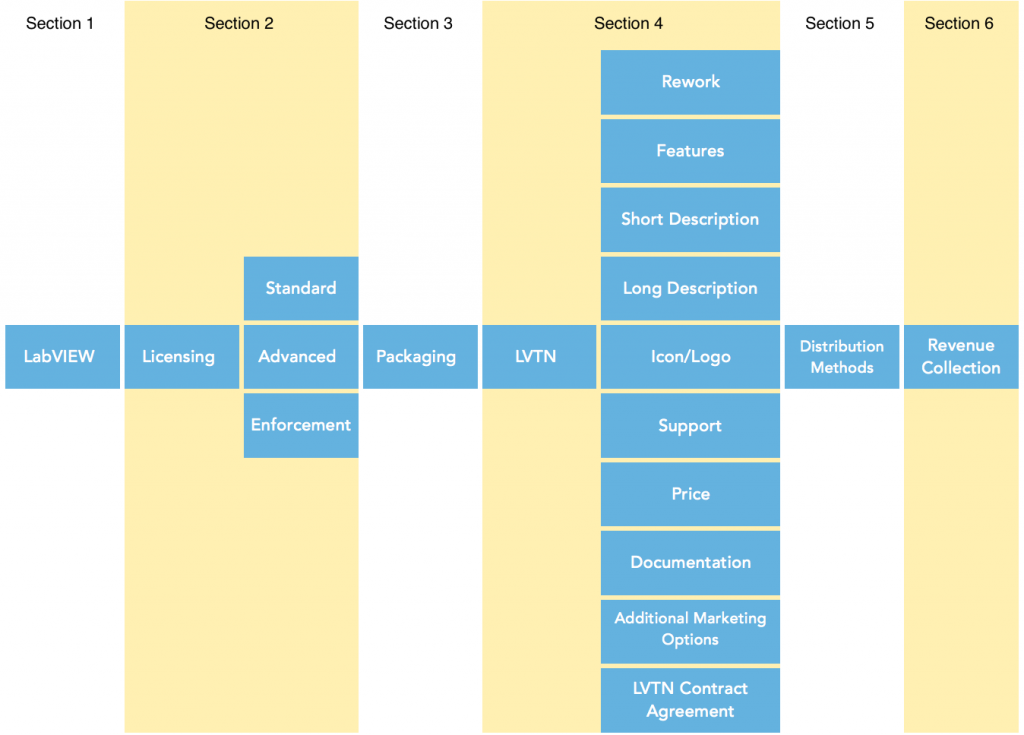Introduction
This part will briefly explain the contents of each section in relation to the whole process. Reading this thoroughly can help you to decide which sections are relevant to your use case and which are not. It will also give you a good start for your time planning and allocation of resources.
The Full Picture
The image below shows the full process from start to finish and highlights the amount of work required even after the development side is completed.
As can be seen, the process can be split into 6 sections and each section will be covered in a separate document. More details of each section are given below.

NOTE: Sections 1, 2 and 3 are required for submission to the LabVIEW Tools Network.
Section Descriptions
Section 1
This section covers the LabVIEW development side, with the aim of helping the user to meet the LVTN requirements on the first attempt. Spending some time on these requirements during development will save a lot of time in the end.
Section 2
This section covers the licensing aspect of the process, it will describe the difference between Standard Licensing and Advanced Licensing and how you can enforce the license once your product is sold. Depending on your choices this could involve the purchase of software and paying a monthly subscription for the licensing server, so if you have a complicated purchasing process it may be good to make these decisions towards the beginning of the project.
If you do not wish to license your product then this section can be skipped.
Section 3
This section covers how you wish to package you product, this is linked to the LVTN requirements and also has an impact on your licensing process. Choosing the correct packaging method can make distributing your product much easier.
Section 4
Once your product has successfully been through the Tools Network review/testing process there are multiple tasks that need to be done before it can be displayed on the Tools Network section of the NI website. This section describes these extra activities and gives tips on making this process more efficient, depending on the size of your organisation.
Even if you do not wish to sell or distribute your product on the LVTN, it may still be worth reading this section as some of the tasks may still be relevant if you wish to distribute your product by other methods.
Section 5
Even if you are giving away your product for free, you will still need some kind of distribution method. Your choices for this will depend on any number of things, such as the size of your organisation, if the product will be fully supported, etc.
Section 6
Revenue collection presents probably the biggest number of options, all with different benefits and drawbacks. This section highlights some of the most common options and gives pointers towards both financial and time costs. If you already have an eShop on your website selling software then this section can probably be skipped, however if you only sell physical products then there may be some small points of interest.
Building a Business Case
Something that is not really part of the development process but is however an important part of the whole project is creating a business case for the product. A business case is something that would be presented to management in order for them to approve you spending time on this project and not others. It will also give an idea of timescales, costs (both in time and financial) and benefits to the company.
For a commercial product that you intend to sell, either to the public or to business, then the benefit to the company is financial. If however your product is for internal use — for example a standardised template for use by all internal LabVIEW developers — then the benefit will be more in terms of time savings and reduced training costs.
If you are working for a large company then chances are you have responsibilities that need to be carried out on a day to day basis. If your sole responsibility is to develop this product then great, there is probably no need to create a business case to justify you spending your time one it.
However it is more likely that creating this product is not your main role and you will need to find time in your schedule for this project. This is where creating a good, solid business case will come in useful. It will show your manager the resources required (including your time) and the benefit for the company when the project is completed.
The amount of your time required will depend on how much of the workload can be outsourced, this will probably also depend on the size of your company. If you have a dedicated marketing department then a lot can be assigned to them, same if you already have a team who work on your eCommerce stuff. It could be that after completing the first 3 sections of the project your role turns in to that of project manager, rather than project doer.
